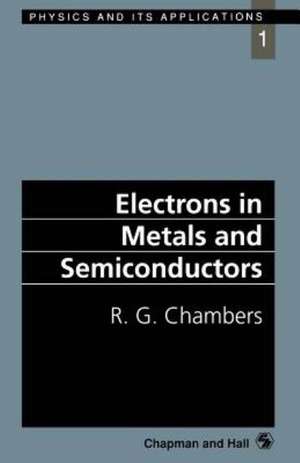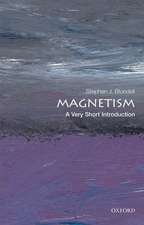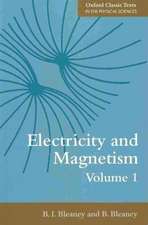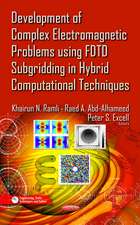Electrons in Metals and Semiconductors: Physics and Its Applications
Autor R.G. Chambersen Limba Engleză Paperback – 31 mai 1990
Preț: 635.65 lei
Preț vechi: 747.82 lei
-15% Nou
Puncte Express: 953
Preț estimativ în valută:
121.65€ • 126.53$ • 100.43£
121.65€ • 126.53$ • 100.43£
Carte tipărită la comandă
Livrare economică 14-28 aprilie
Preluare comenzi: 021 569.72.76
Specificații
ISBN-13: 9780412368400
ISBN-10: 0412368404
Pagini: 240
Ilustrații: 240 p.
Dimensiuni: 140 x 216 x 13 mm
Greutate: 0.29 kg
Ediția:Softcover reprint of the original 1st ed. 1990
Editura: SPRINGER NETHERLANDS
Colecția Springer
Seria Physics and Its Applications
Locul publicării:Dordrecht, Netherlands
ISBN-10: 0412368404
Pagini: 240
Ilustrații: 240 p.
Dimensiuni: 140 x 216 x 13 mm
Greutate: 0.29 kg
Ediția:Softcover reprint of the original 1st ed. 1990
Editura: SPRINGER NETHERLANDS
Colecția Springer
Seria Physics and Its Applications
Locul publicării:Dordrecht, Netherlands
Public țintă
ResearchCuprins
1 The free-electron model.- 1.1 The classical Drude theory.- 1.2 Fermi—Dirac statistics.- 1.3 The Sommerfeld model.- 1.4 The density of states.- 2 Properties of free-electron solids.- 2.1 The electronic heat capacity.- 2.2 The magnetic susceptibility.- 2.3 Transport properties.- 2.4 Hall effect and magnetoresistance.- 2.5 Relaxation effects: high-frequency conductivity.- 2.6 Metals and semiconductors.- 3 Crystal structures and the reciprocal lattice.- 3.1 Crystal structures.- 3.2 The reciprocal lattice.- 4 Electrons in a periodic potential.- 4.1 Bloch’s theorem.- 4.2 The Brillouin zone.- 4.3 Nearly free electrons.- 5 Electronic band structures.- 5.1 The band structure of real metals.- 5.2 Metals, semiconductors and insulators.- 5.3 Density of states and heat capacity.- 6 The potential V(r); many-body effects.- 6.1 The one-electron approximation and the choice of V(r).- 6.2 Many-body effects.- 7 The dynamics of Bloch electrons.- 7.1 The velocity and the Lorentz force.- 7.2 Orbits in a magnetic field.- 7.3 Orbit quantization.- 7.4 The de Haas—van Alphen effect.- 8 Collisions.- 8.1 Scattering by static defects.- 8.2 Phonon scattering.- 8.3 Relaxation times and mean free paths.- 9 Electrical conductivity of metals.- 9.1 The basic expression for ?.- 9.2 Temperature dependence of ?.- 9.3 Matthiessen’s rule.- 9.4 The Kondo effect.- 10 Metals in a temperature gradient.- 10.1 Thermal conductivity.- 10.2 Thermoelectric effects.- 11 Magnetoresistance and Hall effect.- 11.1 Basic ideas: the free-electron model.- 11.2 Real metals.- 12 Radio-frequency, optical and other properties.- 12.1 Radio-frequency properties.- 12.2 Optical and other properties.- 13 Carriers in semiconductors.- 13.1 The number of carriers.- 13.2 Donors and acceptors.- 13.3 Carrier mobilities andpositive holes.- 14 Transport properties of semiconductors.- 14.1 Scattering.- 14.2 Simple transport properties.- 14.3 Cyclotron resonance and optical properties.- 14.4 Orbit quantization and the quantum Hall effect.- 15 Other topics.- 15.1 Charge density waves.- 15.2 Disordered alloys.- 15.3 Localization.- Problems.- Answers to problems.- Further reading.

















